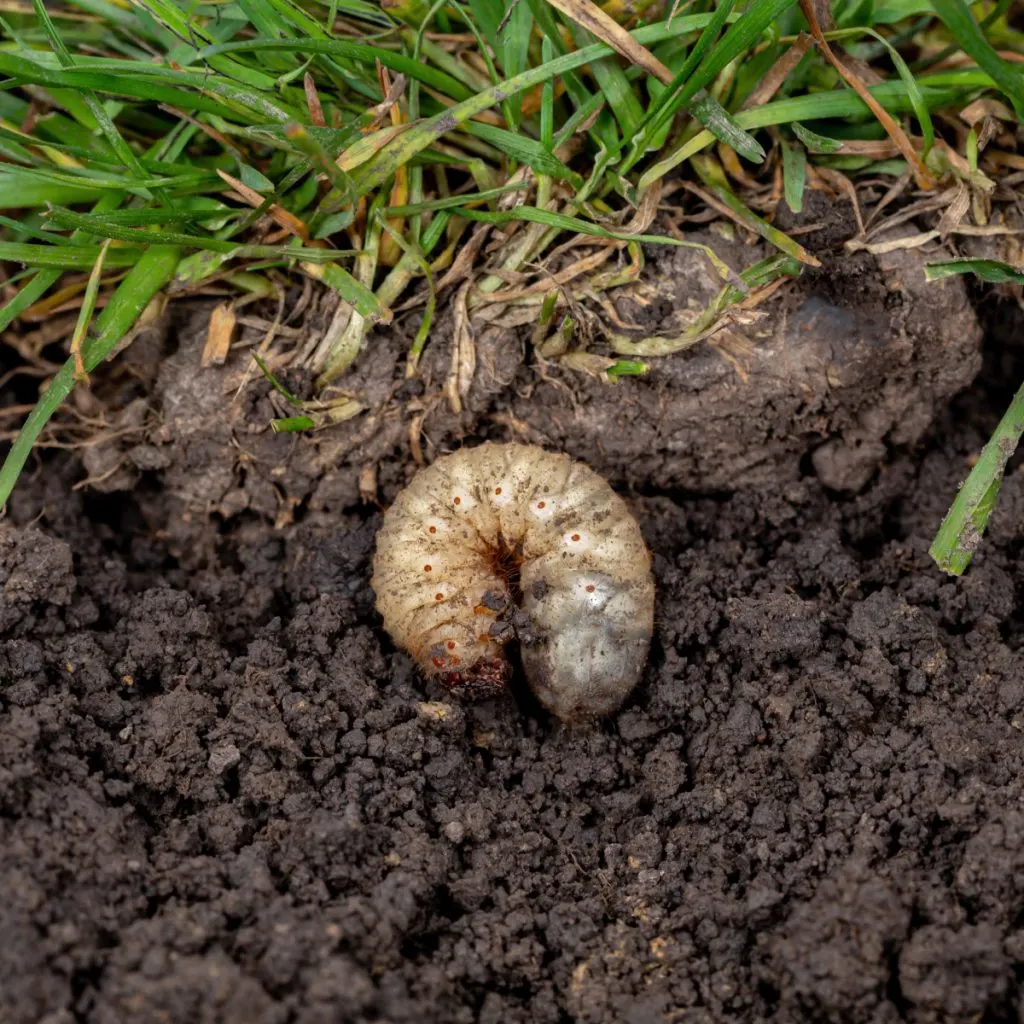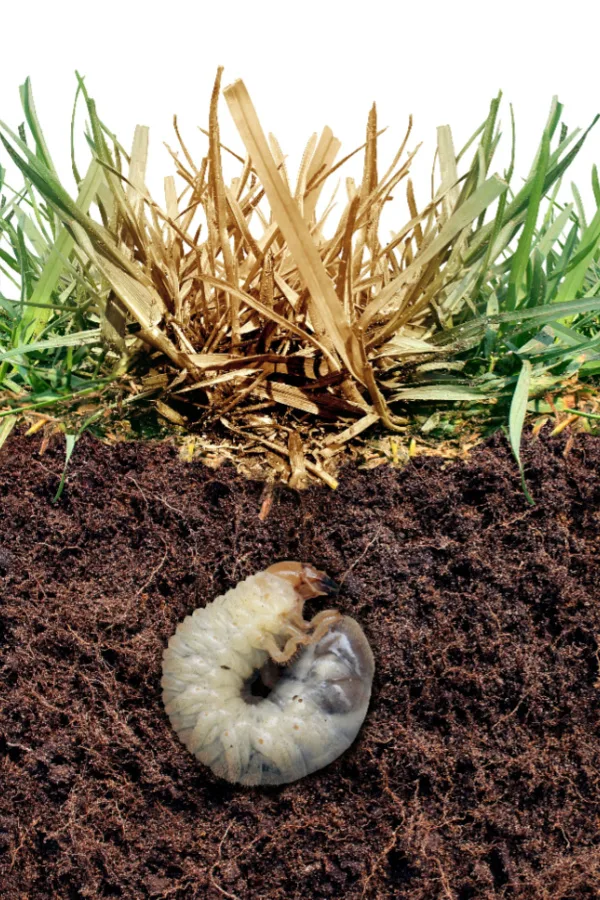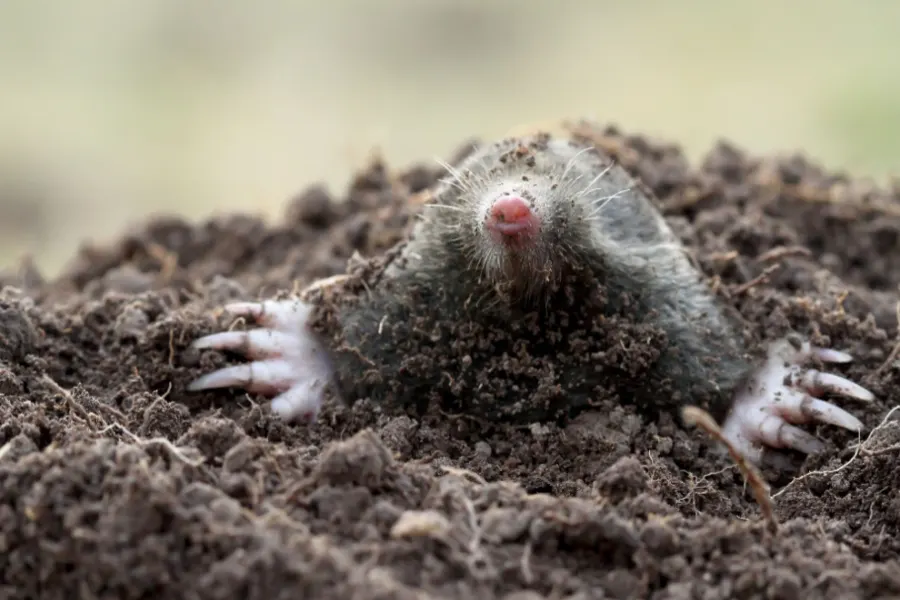One of the best ways to stop ground moles from destroying your lawn and landscape every year is to eliminate the grubs in your yard – and as it just so happens, early spring is the best time to do it!
Grubs are the larvae of beetles, the most common of which are Japanese beetles. Grubs can also take the form of June beetles, chafer beetles, dung beetles and a host of other beetle species as well. But no matter the beetle, they can all do serious damage to your lawn and landscape. And in all kinds of ways!
In the ground, as larvae, grubs feed on the roots of grass and organic matter in the soil. Unfortunately, when they do, they can damage lawns severely. When in large enough numbers, they feed on roots so heavily that it will cause the grass above the soil to turn brown.

If you have ever noticed big brown patches of grass in your yard, more than likely, the culprit is grubs. But if that wasn’t enough, the beetle larvae pose an even bigger threat to the well being of your lawn – and that is that they happen to attract ground moles in droves.
Ground Moles & Grubs – How To Eliminate Grubs In Your Yard
To say that ground moles love to eat grubs would be the understatement of the year. It is actually their favorite food source of all. And when you have grubs in your lawn, you are almost guaranteed to have ground moles as well.
Unfortunately, even though grubs can cause brown spots and turf damage, ground moles digging tunnels through your yard will cause even more. As they dig and burrow looking for grubs, they destroy the roots of grass. So much so that it can completely kill the sod along their tunnel lines.
If all of that wasn’t enough damage from grubs, there is also the destruction they bring once they come out of the soil. For those grubs that survive an attack from ground moles, they emerge to become adult beetles. Beetles that then attack the plants growing in your garden and landscape!
Japanese beetles will feed on the foliage and blooms of roses, fruit trees, grapes and a host of other plants, bushes and shrubs. Not only can the damage be unsightly, if severe enough, it will kill plants. And many of the other beetle species that emerge create similar damage as well.

One thing is for sure, it’s easy to see how much trouble grubs cause. And even more, how important it can be to keep them out of your yard! After all – if you eliminate the grubs, you eliminate all of the issues they bring, including ground moles! See: How To Eliminate Ground Moles For Good
How To Eliminate Grubs In Your Yard – And Why Spring Is The Time To Do It!
The best time to get control of grubs is in early spring. Getting after them at this point helps you not only stop them before grubs can emerge, it also helps keep your lawn safe from mole attacks early in the season!
In the cold winter months, grubs go far down in the soil to stay safe from freezing. But in the spring, they come back near the surface to feed and prepare for emerging. When they do this, a simple and easy to apply application of beneficial nematodes can put a huge dent in their population. And even better, a long lasting one!
So what are beneficial nematodes? Nematodes are tiny microscopic worms that cannot be seen by the human eye. They live in the upper layers of moist soil and they are amazing at attacking grubs, caterpillars, cutworms and more.

Beneficial nematodes work down through the soil to find slugs and other pests. When they find them, they drill in and enter the back mantle of the slug or pest. There they infect it with bacteria that ultimately kills it.
But even more, they reproduce as well in the host pest. When they do, they eventually release even more nematodes that search out more slugs and pests. Talk about a natural predator!
Applying Beneficial Nematodes To Your Lawn – How To Eliminate Grubs In Your Yard In The Spring
So how do you apply beneficial nematodes to your lawn? And are they really safe? Let’s first cover the safety issue. Yes, beneficial nematodes are safe for humans, pets, children. They are even safe for earthworms too!
Beneficial nematodes live in the soil and the bacteria that they inject into slugs and caterpillars will not harm other living organisms. There are harmful nematodes that can injure tomato and other plants – but these nematodes are not the same.
So how exactly do you get beneficial nematode into the soil of your lawn? It’s actually quite easy. You simply mix them with water and spray them on it!
To do this, you can use a backpack sprayer, a hand held sprayer, or even a simple watering can to apply them over the surface of the soil. How you put them on really depends on how big of an area you need to cover.
Remember that these nematodes are microscopic. Because of that, they can be mixed into water and sprayed to cover the soil quite easily – whether a large lawn or a small backyard lot. Wherever you spray them, they root down in and go looking for slugs!
You can purchase nematodes by the millions per package. The good news is that they are not terribly expensive in the least. In fact, you can purchase anywhere from 5 to 50 million nematodes for less than $30. As a reference point, about 10 million nematodes will cover an acre of land! Affiliate Link: Natures Good Guys – Triple Blend Beneficial Nematodes HB+SC+SF (50 Million)
When To Spray Nematodes – How To Eliminate Grubs In Your Yard In The Spring
You can actually spray on nematodes in the early spring or fall. With that said, spring is the best time of all because it gives you a jump on the grubs and stops their cycle of breeding and laying more larva for the next season.
When applying in early spring, it’s important to spray your lawn and garden for grubs in early – but not too early. In order for beneficial nematodes to be effective and for the grubs to be near the surface, it’s best to wait until daytime temperatures are above 50° (F) and the soil is above 45° (F).

This is great in early spring and fall, but you should avoid spraying in summer. When temperatures rise above 80° (F), the nematodes begin to lose their ability to enter the host grub. Unfortunately, in the hot summer months, it’s just not effective to knock them out.
For detailed instructions on spraying, it’s always best to read the package thoroughly from where you purchase your nematodes. One thing to note is when they ship to you, they will need to be kept cool in a refrigerator until you use them to keep them alive.
In addition to the spring application, it is a great idea to follow up in the first year with a second spraying in the fall. This can be a great one-two combination to get rid of any grubs that have been deposited by beetles after mating.
One thing is for sure, after a few applications, your lawn should be more than free of a grub infestation – and along with it, the ground moles should have moved on as well. Here is to eliminating grubs in the early spring this year!
This Is My Garden
Follow Our Facebook Page For Great Gardening Tips And Advice! This Is My Garden Facebook Page
This Is My Garden is a garden website created by gardeners, for gardeners. Jim and Mary Competti have been writing gardening, DIY and recipe articles and books and speaking for over 15 years from their 46 acre Ohio farm. They publish three articles every week, 52 weeks a year. Sign up today to follow via email, or follow along!

